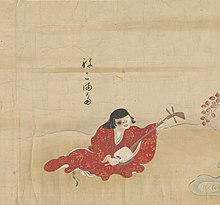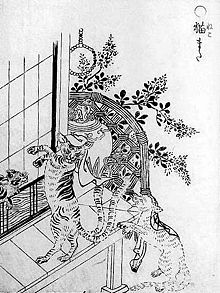Nekomata

Nekomata(original form:Miêu また,later forms:Miêu lại,Miêu cổ,Miêu hông) are a kind ofcatyōkaidescribed in Japanese folklore, classicalkaidan,essays, etc. There are two very different types: those that live in the mountains and domestic cats that have grown old and transformed intoyōkai.[1]Nekomataare often confused withbakeneko.
Mountain Nekomata[edit]

Nekomataappear in stories even earlier than in Japan. In theSui dynasty,the wordsMiêu quỷandKim hoa miêudescribed mysterious cats. In Japanese literature, thenekomatafirst appeared in theMeigetsukibyFujiwara no Teikain the earlyKamakura period:in the beginning ofTenpuku(1233), August 2, in Nanto (nowNara Prefecture), a nekomata (Miêu hông) was said to have killed and eaten several people in one night. The nekomata was described as a mountain beast: according to theMeigetsuki,"They have eyes like a cat, and have a large body like a dog." An essay inYoshida Kenkō's 1331Tsurezuregusaasserts, "In the mountain recesses, there are those called nekomata, and people say that they eat humans...(Áo sơn に, miêu またといふも の ありて, người を thực ふなると người の ngôn ひけるに……)."[2][3]
Many people question whether the nekomata is a cat monster.[2]Since people are said to suffer an illness called "nekomata disease(Miêu vượt bệnh)",some interpret thenekomatato be a beast that has caughtrabies.[4]
Even in thekaidancollections, the "Tonoigusa(Túc thẳng thảo)"and the" Sorori Monogatari(Từng Lữ lợi vật ngữ),"nekomataconceal themselves in mountain recesses. There are stories that deep in the mountains they shapeshift into humans.[5][6]In folk religion there are many stories of mountainousnekomata.[1]In later literature, the mountainnekomatatend to be larger. In the "Shin Chomonjū(Tân nghe tập)"nekomatacaptured in the mountains ofKii Provinceare as large as awild boar;in the "Wakun no Shiori(Oa huấn san)"of 1775 (Anei 4), their roaring echos throughout the mountain, and they can be seen as big as alionorleopard.In the "Gūisō(Ngụ ý thảo)"of 1809 (Bunka 6), anekomatathat held a dog in its mouth was described as having a span of 9 shaku and 5 sun (about 2.8 meters).[2]
InEtchū Province(nowToyama Prefecture), inAizu,atNekomatayamasaid to be wherenekomatawould devour humans (nowFukushima Prefecture),nekomatathat shapeshift into humans and deceive people, likeMount Nekomadake,the legends sometimes are named after the name of the associated mountain.[4]Regarding Nekomatayama and altogether disregarding folklore, there are large cats that attack humans.[7]
Domestic Cat Nekomata[edit]
At the same time, in thesetsuwacollectionKokon Chomonjū,in the story "Kankyō Hōin(Quan giáo pháp ấn)",an old cat raised in a villa on a mountain precipice held a secret treasure, a protective sword, in its mouth and ran away. People chased the cat, but it disguised itself. In the aforementionedTsurezuregusa,aside fromnekomatathat conceal themselves in the mountains, there are descriptions of pet cats that grow old, transform, and eat and abduct people.[3]
Since the Edo period, it has become generally believed that domestic cats turn intonekomataas they grow old, and mountainousnekomatahave come to be interpreted as cats that have run away to live in the mountains. As a result, throughout Japan, a folk belief developed that cats should not be kept for long periods.[1]
In the "Ansai Zuihitsu(An trai tuỳ bút)"the courtierSadatake Isestated, "A cat that is several years of age will come to have two tails, and become theyōkaicalled nekomata. "The mid-Edo period scholarArai Hakusekistated, "Old cats become 'nekomata' and bewilder people." and indicated that at that time it was common to believe that cats becomenekomata.Even the Edo-periodKawarabanreported this strange phenomenon.[2]
In the bookYamato Kaiiki(Đại cùng quái dị nhớ"Mysterious stories from Japan" ), written by an unknown author in 1708, one story speaks of a richsamurai's haunted house where the inhabitants witnessed severalpoltergeistactivities. Attempting to end those events, the samurai called upon countlessshamans,priestsand evokers; but none of them could locate the source of the terror. One day, one of the most loyal servants saw his master's aged cat carrying in its mouth ashikigamiwith the samurai's name imprinted on it. Immediately shooting a sacred arrow, the servant hit the cat in its head; and as it lay dead on the floor, everyone could see that the cat had two tails and therefore had become anekomata.With its death, the poltergeist activities ended. Similar eerie stories about encounters withnekomataappear in books such asTaihei Hyakumonogatari(Thái bình trăm vật ngữ,engl.Collection of 100 fairy tales), written by Yusuke (Hữu tá,or Yūsa) in 1723 and inRōō Chabanashi(Bà lão trà lời nói,Tea-time gossip of old ladies), by Misaka Daiyata (Tam bản đại di), 1742.
It is generally said that the "mata" (Lại) of "nekomata" refers to their having two tails, but from the perspective offolkloristics,this appears questionable. Sincenekomatatransform as they age,mata"repetition" is postulated. Alternatively, since they were once thought to be mountain beasts, there is a theory that "mata" (Viên) refers to monkeys sincenekomatacan come and go freely among the mountain trees.[8]There is also a theory that the term derives from how cats that grow old shed the skin off their backs and hang downwards, making it appear that they have two tails.[9]
In Japan, cats are often associated with death, and this particular spirit is usually blamed. Far darker and more malevolent than mostbakeneko,the nekomata is said to have powers of necromancy and, upon raising the dead, will control them with ritualistic dances, gesturing with paw and tail. Theseyōkaiare associated with strange fires and other inexplicable occurrences. The older and more abused a cat is before its transformation, the more power the nekomata is said to have. To gain revenge against those who wronged it, the spirit may haunt humans with visitations from their deceased relatives. Some tales state that these demons, likebakeneko,assume human appearances, usually appearing as older women, misbehaving in public, and bringing gloom and malevolence wherever they travel. Due to these beliefs, sometimes kittens' tails were cut off based on the assumption that if the tails could not fork, the cats could not become nekomata.
From this discernment and strange characteristics, nekomata have been considered devilish from time immemorial. Due to fears and folk beliefs such as the dead resurrecting at a funeral or that seven generations would be cursed due to killing a cat, it is thought that the legend of thenekomatawas born.[4][10]Also, in folk beliefs cats and the dead are related. As carnivores, cats have a keen sense of detecting the smell of rot, so it was believed that they had a habit of approaching corpses; with this folk belief sometimes thekasha,ayōkaithat steals corpses are seen to be the same as the nekomata.[1]
Also in Japan there are catyōkaicalledbakeneko;and since nekomata are theyōkaiof transformed cats, sometimesnekomataare confused withbakeneko.[11]
Yōkai Depictions[edit]


In the Edo period many books illustrating and describingyōkaiwere published (yōkai emaki), with nekomata frequently depicted. TheHyakkai Zukanpublished in 1737 (Gembun 2) includes an illustration of anekomataassuming the appearance of a woman playing ashamisen.(See the first image on this page.) Since Edo-period shamisen frequently used cat skins, that particular nekomata sang a sad song about its species as it plucked the strings.[1]Understandably, the image has been interpreted as ironic.[12]As for thenekomata's wearinggeishaclothing, sometimesnekomataand geisha are considered related since geisha were once called "cats (neko) "[12]
Also shown at the right, theGazu Hyakki Yagyōof 1776 (An'ei 5) depicts a cat with its head protruding from a shōji screen, a cat with a handkerchief on its head and its forepaw on the veranda, and a cat wearing a handkerchief and standing upright. The less experienced cat has difficulty standing on its hind legs. The older cat can do so: this is showing the process by which a normal cat ages and transforms into anekomata.[12]In the Bigelow ukiyo-e collection at theMuseum of Fine Arts, Boston,theHyakki Yagyō Emakiincludes a similar composition, leading some scholars to see a relationship between the books.[13]
Senri[edit]
In Chinese lore there is a cat monster called thexiānlí(Tiên li) "(Japanese pronunciationsenri,where "Chinese:Li"means"leopard cat"). In this telling, leopard cats that grow old gain adivine spiritual power (xianarts),shapeshift into a beautiful man or woman, and suck the spirit out of humans.[14]Some theorize that the Japanese nekomata legends derive from Chinese xiānlí tales.[15]
See also[edit]
- Kasha
- Kuroneko— a 1968 horror film featuring vengeful cat spirits
- Maneki-neko
- Kaibyō
Notes[edit]
- ^abcdeNhiều điền(2000), 170–171Trang.
- ^abcdThế gian(1994), 127–128Trang.
- ^abBình nham(1992), 36–66Trang.
- ^abcThạch xuyên(1986), 696Trang.
- ^Địch điền an tĩnh biên (1989). "Túc thẳng thảo". In cao điền vệ biên ・ giáo trung (ed.).Giang hộ quái đàm tập.Nham sóng kho sách. Vol. Thượng. Nham sóng hiệu sách. pp. 121–124.ISBN978-4-00-302571-0.
- ^Biên tác giả bất tường (1989). "Từng Lữ lợi vật ngữ". In cao điền vệ biên ・ giáo trung (ed.).Giang hộ quái đàm tập.Nham sóng kho sách. Vol. Trung. Nham sóng hiệu sách. pp. 57–58.ISBN978-4-00-302572-7.
- ^Cốc xuyên kiện một (1998).続 Nhật Bản の địa danh.Nham sóng sách mới. Nham sóng hiệu sách. p. 146.ISBN978-4-00-430559-0.
- ^Ngày dã 巌 (2006).Động vật yêu quái đàm.Trung công văn kho. Vol. Hạ. Trung ương công luận tân xã. pp. 158–159.ISBN978-4-12-204792-1.
- ^"ネコ の うんちく".Nyanmaru. Archived fromthe originalon 2012-11-14.Retrieved2012-11-03.
- ^Tá dã hiền trị hắn (1980). Anh giếng đức quá lang biên (ed.).Dân gian tín ngưỡng từ điển.Đông Kinh đường xuất bản. p. 223.ISBN978-4-490-10137-9.
- ^Kinh cực hạ ngạn (2010). "Yêu quái の yến yêu quái の hộp đệ 6 hồi". In quận tư thông hắn biên (ed.).Quái.カドカワムック. Vol. 0029. Giác xuyên hiệu sách. p. 122.ISBN978-4-04-885055-1.
- ^abcCổ sơn hắn(2005), 155Trang.
- ^Canh bổn hào một biên (2006).続・ yêu quái đồ quyển.Quốc thư phát hành sẽ. pp. 161–165.ISBN978-4-336-04778-6.
- ^Kỷ nguyên mới xã biên tập bộ (2003). Kiện bộ duỗi minh giam tu (ed.).Thật ・ nữ thần 転 sinh ác ma sự điển.Truth In Fantasy. Kỷ nguyên mới xã. p. 94.ISBN978-4-7753-0149-4.
- ^Một cái thật cũng giam tu (2010).Thế giới の huyễn thú エンサイクロペディア.Giảng nói xã. p. 194.ISBN978-4-06-215952-4.
References[edit]
- Thạch xuyên thuần nhất lang hắn (1986). Càn khắc kỷ hắn biên (ed.).Nhật Bản vân kỳ vân nói đại sự điển.Giác xuyên hiệu sách.ISBN978-4-04-031300-9.
- Thế gian lương ngạn (1994).Đồ nói ・ Nhật Bản chưa xác nhận sinh vật sự điển.Bách thư phòng.ISBN978-4-7601-1299-9.
- Nhiều điền khắc kỷ (2000). Kinh cực hạ ngạn ・ nhiều điền khắc kỷ biên (ed.).Yêu quái đồ quyển.Quốc thư phát hành sẽ.ISBN978-4-336-04187-6.
- Bình nham mễ cát (1992). "Miêu cổ vân nói の 変 dời".Miêu の lịch sử と kỳ lời nói.Trúc mà thư quán.ISBN978-4-806-72339-4.
- Cổ sơn hoa quế hắn (2005). Bá ma học viện nghiên cứu biên (ed.).Bá ma の dân tục dò hỏi.Thần hộ tin tức tổng hợp xuất bản センター.ISBN978-4-343-00341-6.
- Patrick Drazen:A Gathering of Spirits: Japan's Ghost Story Tradition: from Folklore and Kabuki to Anime and Manga.iUniverse, New York 2011,ISBN1-4620-2942-6,page 114.
- Elli Kohen:World history and myths of cats.Lewiston, New York:Edwin Mellen Press2003,ISBN0-7734-6778-5,page 48–51.
- Carl Van Vechten:The Tiger In The House.Kessinger Publishing, Whitefish 2004 (Reprint),ISBN1-4179-6744-7,page 96.
External links[edit]
- Nekomata – The Split-Tailed Catat hyakumonogatari (English)
